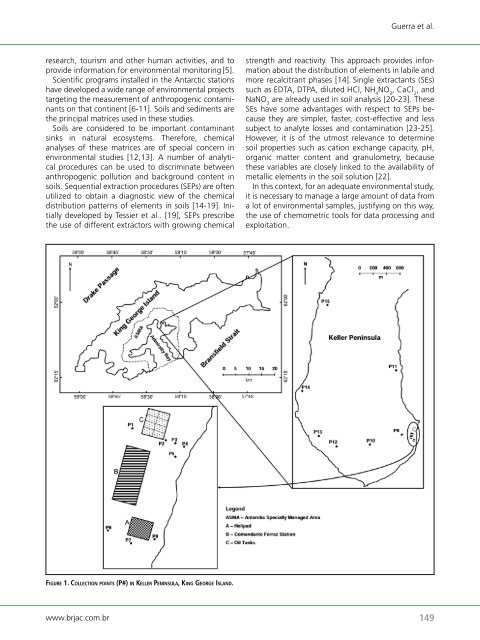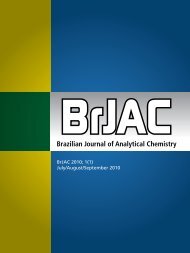Brazilian Journal of Analytical Chemistry - BRJAC - Brazilian Journal ...
Brazilian Journal of Analytical Chemistry - BRJAC - Brazilian Journal ...
Brazilian Journal of Analytical Chemistry - BRJAC - Brazilian Journal ...
Create successful ePaper yourself
Turn your PDF publications into a flip-book with our unique Google optimized e-Paper software.
esearch, tourism and other human activities, and to<br />
provide information for environmental monitoring [5].<br />
Scientific programs installed in the Antarctic stations<br />
have developed a wide range <strong>of</strong> environmental projects<br />
targeting the measurement <strong>of</strong> anthropogenic contaminants<br />
on that continent [6-11]. Soils and sediments are<br />
the principal matrices used in these studies.<br />
Soils are considered to be important contaminant<br />
sinks in natural ecosystems. Therefore, chemical<br />
analyses <strong>of</strong> these matrices are <strong>of</strong> special concern in<br />
environmental studies [12,13]. A number <strong>of</strong> analytical<br />
procedures can be used to discriminate between<br />
anthropogenic pollution and background content in<br />
soils. Sequential extraction procedures (SEPs) are <strong>of</strong>ten<br />
utilized to obtain a diagnostic view <strong>of</strong> the chemical<br />
distribution patterns <strong>of</strong> elements in soils [14-19]. Initially<br />
developed by Tessier et al.. [19], SEPs prescribe<br />
the use <strong>of</strong> different extractors with growing chemical<br />
fi g u rE 1. Co l l E C t i o n P o i n t s (P#) in kEllEr PE n i n s u l a, ki n g gE o rg E is l a n d.<br />
www.brjac.com.br<br />
Guerra et al.<br />
strength and reactivity. This approach provides information<br />
about the distribution <strong>of</strong> elements in labile and<br />
more recalcitrant phases [14]. Single extractants (SEs)<br />
such as EDTA, DTPA, diluted HCl, NH 4 NO 3 , CaCl 2 , and<br />
NaNO 3 are already used in soil analysis [20-23]. These<br />
SEs have some advantages with respect to SEPs because<br />
they are simpler, faster, cost-effective and less<br />
subject to analyte losses and contamination [23-25].<br />
However, it is <strong>of</strong> the utmost relevance to determine<br />
soil properties such as cation exchange capacity, pH,<br />
organic matter content and granulometry, because<br />
these variables are closely linked to the availability <strong>of</strong><br />
metallic elements in the soil solution [22].<br />
In this context, for an adequate environmental study,<br />
it is necessary to manage a large amount <strong>of</strong> data from<br />
a lot <strong>of</strong> environmental samples, justifying on this way,<br />
the use <strong>of</strong> chemometric tools for data processing and<br />
exploitation.<br />
149



